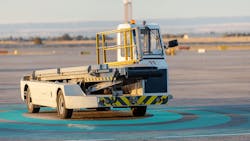Brigade Electronics Focuses on Cost Savings Through GSE Safety Technologies at GSE Expo
Airports have never been busier. With more than 100,000 commercial flights taking off each day according to OAG, safety on the ramp remains paramount.
Ground Support Equipment (GSE) plays a critical role in aircraft turnarounds, but without proper measures in place, it can also become a major source of disruption causing ground damage, delays, and costly Aircraft On Ground (AOG) incidents.
Brigade Electronics Inc., exhibiting at the International GSE Expo in Booth #2068, discusses how tailored GSE safety systems can cut ground damage costs by up to 42%.
Tackling rising ground damage costs with enhanced GSE
According to the International Air Transport Association (IATA), escalating flight volumes could drive ground damage costs to reach US$10 billion by 2035. However, the IATA has also identified that these costs could be cut by up to 42% using Enhanced GSE featuring anti-collision and blind spot technology.
IATA’s 2024 Annual Safety Report shows a slight increase in incident rates - from 1.09 to 1.13 incidents per million flights with seven fatal accidents and 244 onboard fatalities recorded in 2024. However, the industry’s fatality risk remains low at 0.06, significantly under the five-year average of 0.10.
These statistics underline how even minor ground collisions or equipment mishaps can result in significant delays, repairs, or worst-case AOG events and emphasize the need for advanced monitoring and prevention tools.
Understanding the risks: blind spots and collisions
Ground handlers frequently navigate equipment in tight proximity to aircraft, where blind spots around wings, fuselage corners, and cargo doors heighten the risk of impact. Unseen hazards combined with vehicle momentum can lead to dents, skin damage, or structural impairment, potentially resulting in rapid decompression or AOG scenarios if left unchecked.
Ground support equipment encompasses a diverse range of vehicles. From catering trucks and baggage tugs to aircraft pushback tractors, fuel tankers, and passenger transport vehicles, each has its own operational challenges and risk profiles.
Due to their size, design, and operating environments, many of these vehicles suffer from significant blind spots, which can contribute to a variety of incidents including aircraft skin damage, engine ingestion hazards, ground crew injuries, and even aircraft being rendered AOG.
The leading solutions helping to elevate GSE safety
To address these critical safety gaps, Brigade has developed a portfolio of advanced safety technologies tailored to GSE operations. The kits, which were initially developed from existing technologies for catering vehicles to address their proximity and unique use close to aircraft, include:
- The HFR HD Backeye 360 camera system with in-cab monitor, which provides operators with real-time, high-definition 360-degree visual coverage of blind zones around vehicles, allowing for safer maneuvering around aircraft, service roads, and busy apron environments. Featuring cutting-edge Human Feature Recognition (HFR) capable of identifying humans in vehicle blind spots. Using artificial intelligence, the cameras detect and recognize pedestrians within a pre-defined detection zone and reliably notify the operator visually and/or audibly. This system is particularly beneficial for high-riding vehicles like catering or lavatory trucks, which have limited downward visibility. Two toggle switches allow the driver to manually change the view to the correct cameras during initial approach and final approach.
- Two additional cameras are mounted on the right and left sides toward the front of the vehicle and pointed upwards support the initial approach dual screen. These are used during the initial approach and show a split screen is to provide the driver with a clear view of the wing location when approaching the airplane and incorporate a monitor with split screen view.
- A final approach screen is mounted on the forward/top of the vehicle pointing upwards. Drivers can toggle to this screen on final approach to ensure they don't hit under the wing and/or the airplane body when making their final maneuvers towards and alongside the plane.
These technologies work in unison to create a comprehensive risk mitigation system, designed to reduce ground-based collisions, protect valuable assets, and minimize the risk of AOG events caused by equipment-related damage.
“Brigade’s technologies are about more than detecting objects, they’re about providing solutions that give operators the confidence to keep operations running safely and smoothly free from disruption and financial loss," says Corey Heniser, CEO of Brigade Electronics. "With the industry facing billions in potential ground damage costs, our monitoring systems, adaptive alarms, and HD HFR cameras bring clarity and control to the ramp operator’s workspace. They transform blind spots into actionable visibility, helping avoid AOG events before they happen.”
